
|   |

|   |
 e-mail: ukb7@rediffmail.com The spark and the sparkle October 12, 2018 Suddenly the stage was all ablaze. Fiery particles were thrown from the performing faces, limbs and torsos, scattering in all directions and lighting up the surroundings. Suddenly, the bemused spectators discovered that they were in for - no, not the traditional Kathak, but for unmitigated innovation, offered only by the likes of Akram Khan and Aditi Mangaldas that glitter and glisten in the dark. The relatively arid dance scenario of Kolkata offered, for a change, fruits of imagination that did not vitiate the rigorous canons of the hoary style one bit, but soared the sky on wings of sheer, scintillating joy, in the glow of creativity. 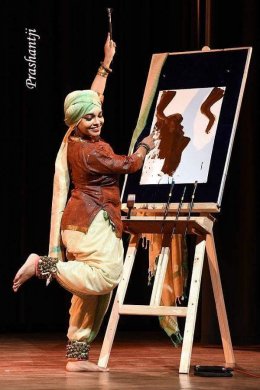 Madhurima Goswamy In Ekaharya Abhinaya, Madhurima presented Manav (Man) symbolising our society and Samay (Time) as the continuing eternity. The latter presented a little nursery of seedlings -- sans soil -- to the former, to look after and nurture with earth and water, in order to blossom into fully-grown trees. Simultaneous with her dancing the Laris with the padhant mnemonics, she wielded painting brushes in both hands and painted away in a frenzied tempo on a free-standing canvas mounted at the front stage. Lo and behold, the dollops of colours seemingly daubed arbitrarily at the moment, metamorphosed into the silhouette of a young woman gazing at a flower, when the canvas was reversed and held before the viewers' eyes! Asked about her inspiration, Madhurima averred, "Once upon a time, many a famous dancer made beautiful images on the floor of the court with colours under their dancing feet. Pt. Birju Maharaj has written in his Anga Sanchalan about Hastak in Kathak being a kind of painting on Universe, without canvas, colour and brush. But then the image of the painting appears on the dancer's figure!" The second offering was Fireflies from Bangladesh, produced by Shadhona, a centre for advancement of South-Asian culture. It was conceptualised by Courtney Sato, a Japanese-American dancer from Hawaii, an avid English poet and later in Bangladesh on a Fulbright endowment; with dance choreography by Amit Chowdhury, a Rabindra Bharati University graduate specialising in Bharatanatyam; and music by Nirjher Choudhury, a senior professional in the Bangladesh media. The captivating programme was based on Tagore's own fascination for Haikus, Japan's unique epigrammatic poems - when he visited that land in 1916 and 1918 -- and tout de suite, came out with his own creative writing in a very similar compact style, which conveyed memorable poetic expressions with great force and brevity. His bilingual Lekhan (1926) and posthumous Sphulinga (1946) contained poems that resemble sayings of a wise man rather than poetry. The reason why he could so easily appreciate the essence of Haiku was that he was an exceptional Renaissance man to whom the briefest Haiku represented the succinct thought on life, beauty or divinity. 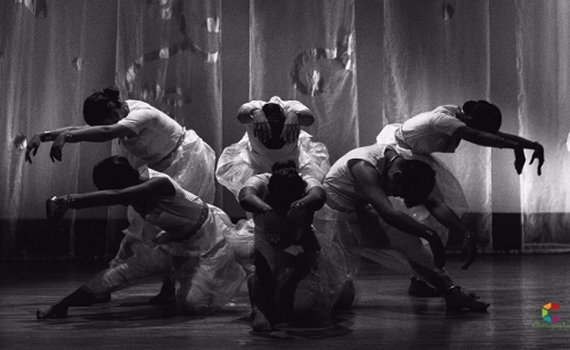
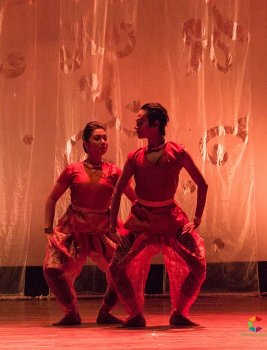
Fireflies
Photos: Anirban Goswami Fireflies - culled from the eponymous Sphulinga -- used, with great impact, ten male and female dancers, exquisitely attired and exceedingly well-trained, to emote to Tagore's own music, interjected with readings from his oeuvre of Haiku, in English, that visualised the crisp spontaneity of his verses. One must specially note that each traditional Haiku is marked by its own kigo (seasonal reference) and a kireji (cutting word). An ardent lover of Nature and seasons, celebrated throughout his large musical outpouring, Tagore must have been delighted with the season-word in Haiku and, similarly, the connecting word would have also come to him instinctively. The shimmering aura in the colourfully-lit backdrop - of a quivering network with applique motifs - lent magical luminosity with amber, blue green, pink, red and violet tints, for water effects and sky effects. The dancers used a wide variety of Bharatanatyam, contemporary and a large dose of Kathak dance styles, to create very imaginative choreography for Tagore's Haikus and flitting songs (or simply the music): Wash away all our filth with the fountain of your light...; I will cross over Death's vast water expanses..; My heart is brimming with your illumination...; The sky is lit with the sun and the stars, and the cosmos with life...; I crave not only for your words but for your caressing touch...; The river surges forth in its own momentum...; The soft breeze blows from blossom to blossom...; The tsunami of lofty waves break on the unsuspecting beaches...; What a grace envelops the soul...; and What a firework of melodies you have wrought on our hearts... 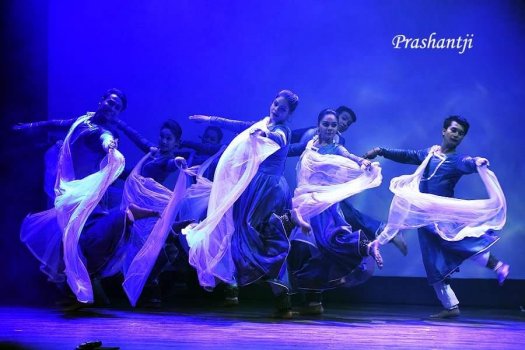
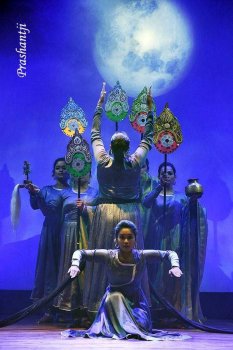
Moonstruck
The final offering was Moonstruck, directed by Ashimbandhu,
as an imaginary conversation - long, resonant and rhythmic - between a
lonely introvert artist and his friend the moon, in a series of
interpolations, some mythic and some modern, exposing the surreal beauty
as well as utmost vulnerability of the moon. Aided by co-dancers -
Ranjani, Jaya, Sukanya, Shilpa and Moumita among the females, and Avik,
Imran and Suvrodeep among the males - Ashimbandhu etched his eternal
attraction for the moon to weave a magic around the moon, with a
brilliant choreography in Kathak.Photos: Prashantji The mythology begins at Samudra Manthan with retrieval of fourteen glittering jewels, the beautiful moon and finally the nectar. Rahu and Ketu rush for gulping down Amrita, get noticed by the moon and are promptly beheaded by the Sudarshan Chakra of Vishnu before the nectar reaches their stomach and to seek revenge, the moon is periodically gobbled by the duo in Grahan and extricated. Tara, the beauteous wife of Guru Brahaspati, is enamoured of the moon and conceives his love-child, only to be cursed by her enraged husband to give birth to the son, Budh, belonging to third gender. The king Daksha gives the moon his twenty-seven daughters in wedlock and commands the moon to spend a night with each. This is duly done, but the moon is in passionate love only with Rohini. When the other brides complain, Daksha curses the moon to perdition. The latter worships Shiva with Maha Mrityunjay hymn with 3,000 devout utterances and is rid of the curse with Shiva's blessing. In the intimate relationship of the artist - both narcissistic and delusional - with the moon, the ancient mythology then yielded to modern cosmology, referring to Neil Armstrong touching down on the moon and one wondered if the moon was now debased to the status of just another ordinary planet. But Ashimbandhu emphasized, "My love for the moon would last eternally, to weave always a magic around its orb." To the wider tapestry, Amit Dasgupta brought in the thread of words; Jayanta Banerjee provided the melodies; and Dinesh Poddar added most innovative lights and colours. All told, it was a very creative evening that brought the best among the classical artists and proved, if a proof was needed, that they could reach for new horizons.  Dr. Utpal K Banerjee is a scholar-commentator on performing arts over last four decades. He has authored 23 books on Indian art and culture, and 10 on Tagore studies. He served IGNCA as National Project Director, was a Tagore Research Scholar and is recipient of Padma Shri. Post your comments Please provide your name and email id when you use the Anonymous profile in the blog to post a comment. All appropriate comments posted with name & email id in the blog will also be featured in the site. |